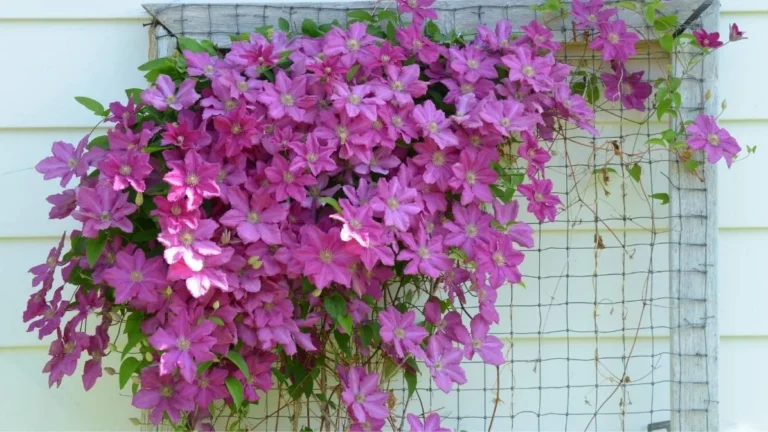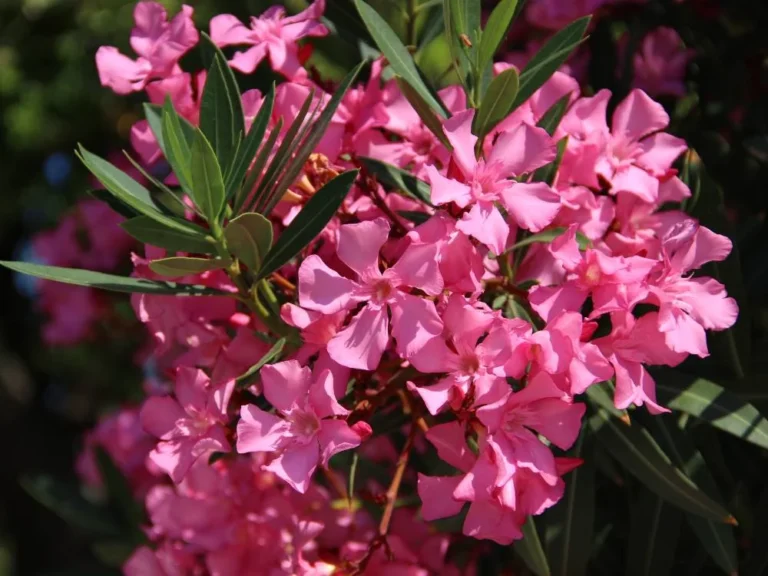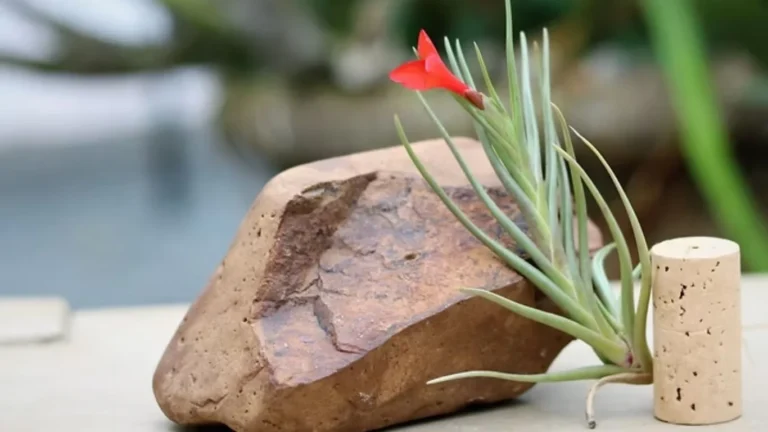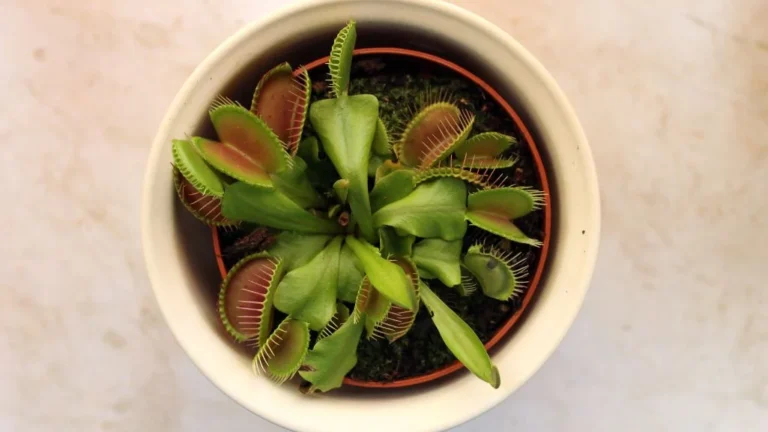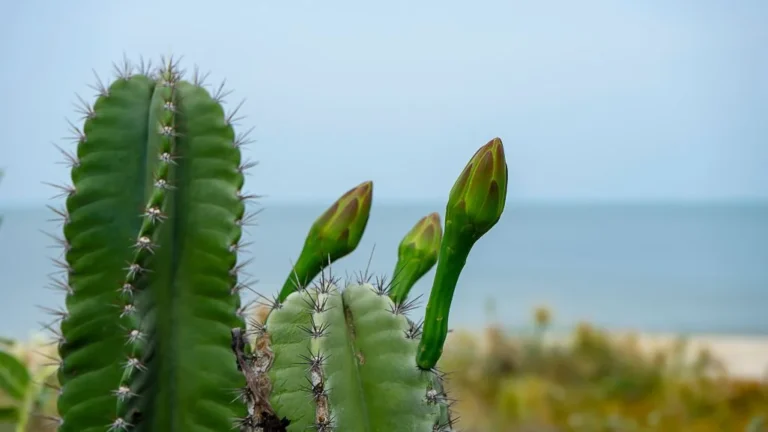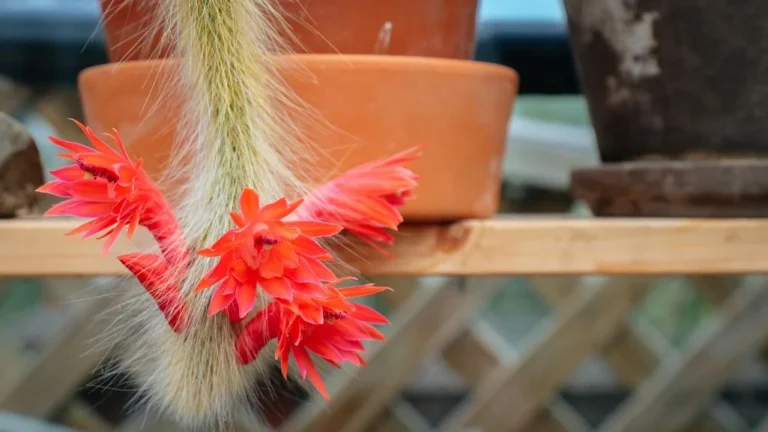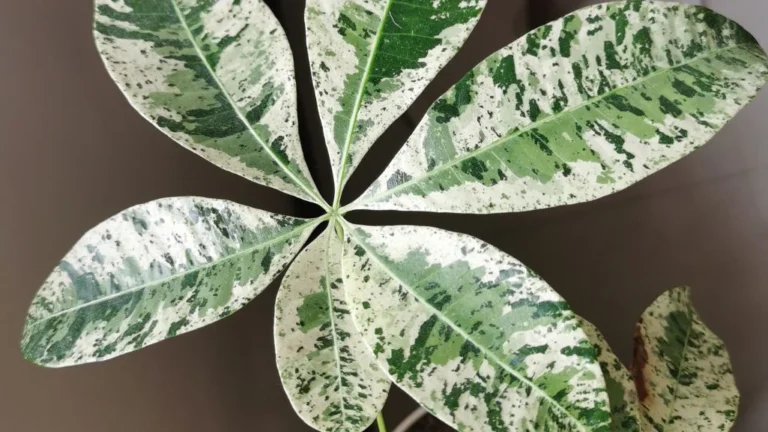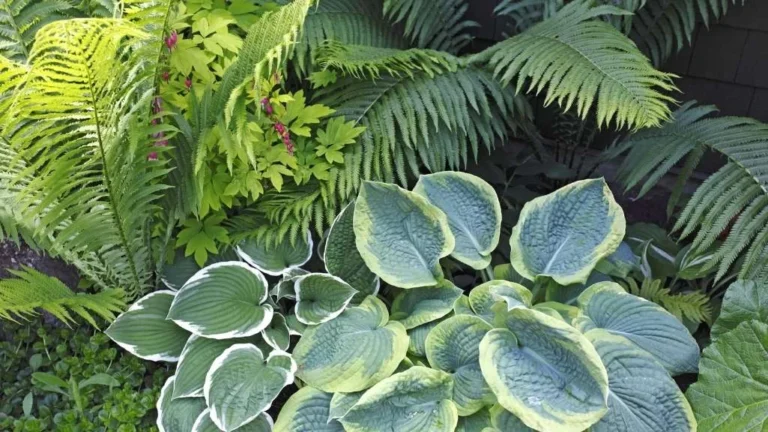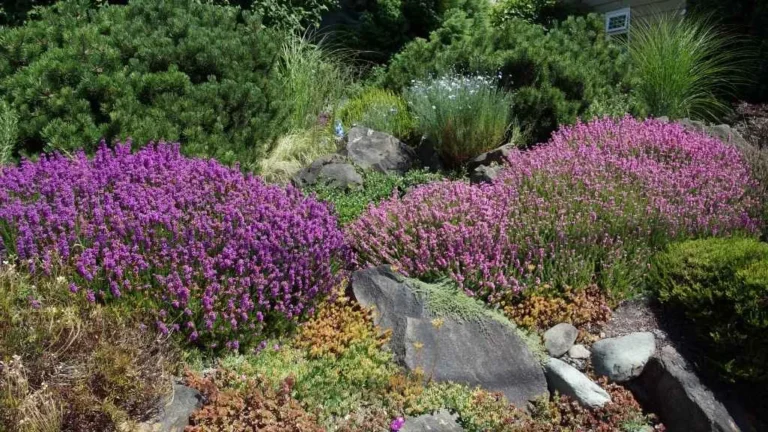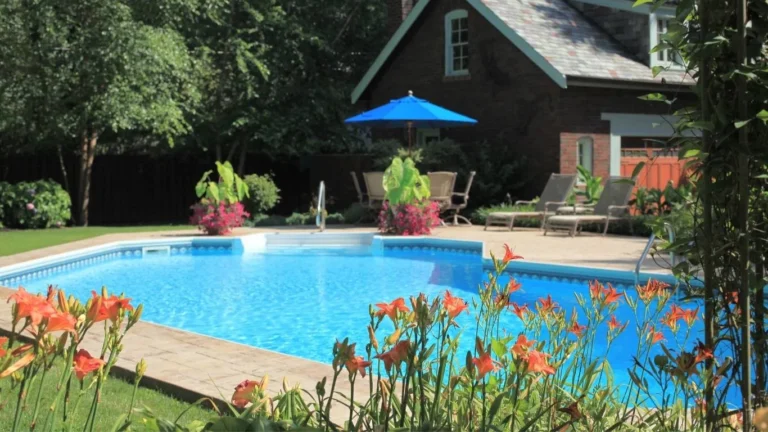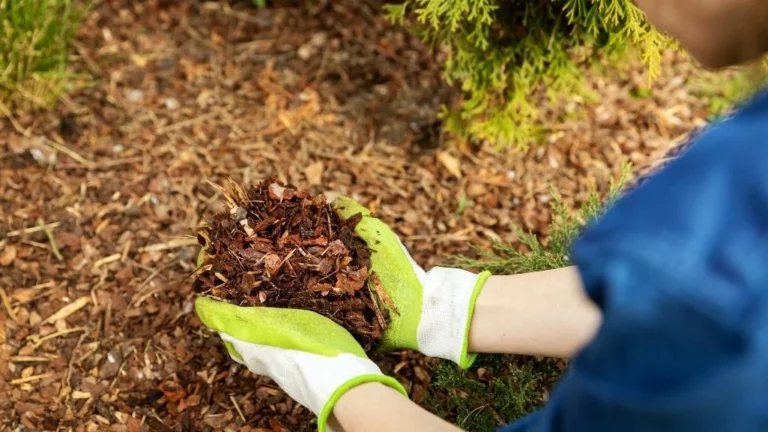Picture this: You step outside into your garden, surrounded by lush greenery and vibrant flowers. Your pet happily romps around, completely safe from the dangers that some plants can pose. Sounds like a dream, right? But it’s entirely possible when you choose pet-friendly climbing plants that look just as good as they feel for your four-legged friends.
As more people embrace gardening as a way to escape the hustle of everyday life, there’s been a growing interest in making outdoor spaces not only beautiful but safe for pets, too. After all, pets are family, and the last thing we want is for them to chew on a toxic plant or get an itchy rash from a prickly vine.
In this blog, we’ll take you through the best pet-friendly climbing plants for your garden. These plants will add a stunning, vertical layer of beauty to your outdoor space while ensuring your pets stay safe. Whether you’re a gardening newbie or a seasoned pro, you’ll find inspiration for creating a pet-friendly paradise that’s as safe as it is stunning.
Why Pet-Friendly Plants Matter
As pet parents, we’re constantly making sure our furry friends are safe, happy, and healthy. But have you ever stopped to think about what’s growing in your garden? Those beautiful plants that look so lovely on your trellises could actually pose serious risks to your pet if you’re not careful.
Choosing pet-safe plants isn’t just about adding some greenery to your space—it’s about creating a safe haven where your pets can roam freely without you worrying about what they might nibble on or touch. Let’s face it: pets are curious creatures. Whether it’s chewing on leaves or rolling around in the dirt, their little adventures can lead to some not-so-pleasant consequences if they come into contact with toxic plants.
Common hazards of toxic plants include everything from ingestion to skin irritation. Some plants can cause mild stomach issues, while others may result in more severe reactions like vomiting, diarrhea, or even poisoning. And let’s not forget about skin sensitivities—certain climbing plants can cause rashes or allergic reactions just by contact. It’s a nightmare no one wants to deal with, especially when your pet is the one suffering.
When planning your garden, it’s important to think beyond just aesthetics. Yes, a beautiful climbing vine or fragrant flower can transform your space, but safety should always be at the top of your mind. You can have the best of both worlds—pet-friendly plants that not only look stunning but also ensure your pets stay safe.
So, let’s make sure your garden is not just a feast for the eyes but a safe playground for your furry friends, too!
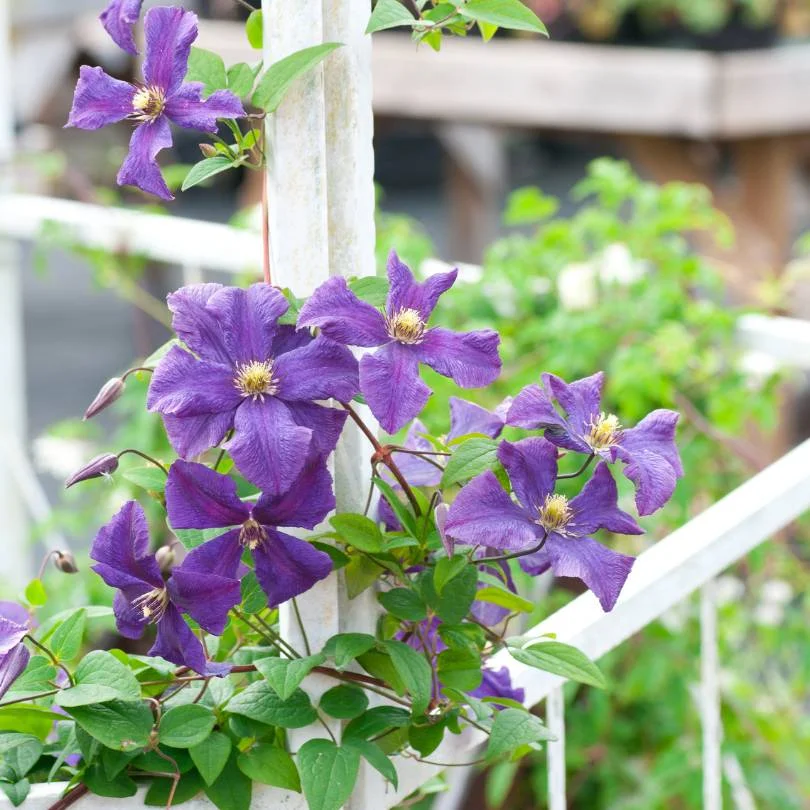
Clematis
If you’re looking for a plant that’s both pet-safe and guaranteed to turn heads, Clematis is your go-to climbing plant. This stunning vine is known for its striking, vibrant flowers that come in a range of colors—from deep purples to soft pinks and even bold reds. It’s the kind of plant that steals the spotlight and makes any garden feel like a botanical paradise.
What makes Clematis even more special (besides its beauty) is that it’s completely safe for pets. No more worrying if your curious pup or cat decides to take a nibble. The vines and flowers are non-toxic, so your furry friends can explore the garden without a second thought.
Clematis loves to climb—whether it’s a trellis, fence, or even up a pergola. And the best part? It’s a perennial, meaning it’ll keep blooming year after year, giving your garden that burst of color every season. While it thrives in full sun and well-drained soil, it’s also fairly low-maintenance, making it perfect for both seasoned gardeners and those just starting out.
With its fast-growing vines and stunning flowers, Clematis not only adds visual appeal but also creates a safe, pet-friendly retreat for you and your four-legged companions. Plus, it attracts pollinators like bees and butterflies, so your garden will be buzzing with life, too.

Hops
If you want a pet-friendly plant that’s as practical as it is stunning, Hops might just be your new best friend. Known for its rapid growth and ability to transform an ordinary fence or wall into a lush, green vertical garden, Hops is perfect for anyone looking to add both beauty and shade to their outdoor space—without worrying about your pet’s safety.
What’s fantastic about Hops is that it’s completely non-toxic to pets. So, whether your dog is trying to sneak a taste of the vine or your cat is investigating the leaves, you can rest easy knowing they’re safe. The climbing nature of Hops makes it ideal for creating natural privacy screens or shaded areas for those hot summer days. It grows quickly, making it an excellent choice for anyone looking to see results fast.
In addition to being a climber, Hops produces small, green cones (though they’re not edible for humans unless you’re brewing beer, of course). They add an interesting texture to your garden and attract pollinators like bees, which is always a plus if you want a thriving, eco-friendly garden.
With its vigorous growth and pet-safe status, Hops is not only a practical addition to your garden but also a conversation starter. It’s the perfect plant for pet owners who want beauty, shade, and peace of mind all in one vine.

Boston Ivy
If you’re looking to add texture and beauty to your garden without the hassle, Boston Ivy is the perfect choice. This low-maintenance climbing vine is not only safe for pets but also offers year-round appeal. With its ability to climb walls, fences, and trellises, it brings a lush, green aesthetic to any space. Come fall, its leaves turn a stunning red, creating a vibrant burst of color that’s a feast for the eyes.
The best part? Boston Ivy is completely non-toxic to pets, so your dog or cat can enjoy the garden without worry. It’s a fantastic option for pet owners who want to keep their furry friends safe while adding some natural beauty to their yard. The vine has a tendency to spread quickly, giving you impressive coverage in no time. And despite its vigorous growth, it doesn’t require a lot of attention—making it ideal for busy gardeners.
This plant thrives in both sun and shade, making it highly adaptable to various garden environments. Whether you’re covering a bland fence or turning a bare wall into a lush green retreat, Boston Ivy will add the perfect touch of texture and color while staying safe for your pets.
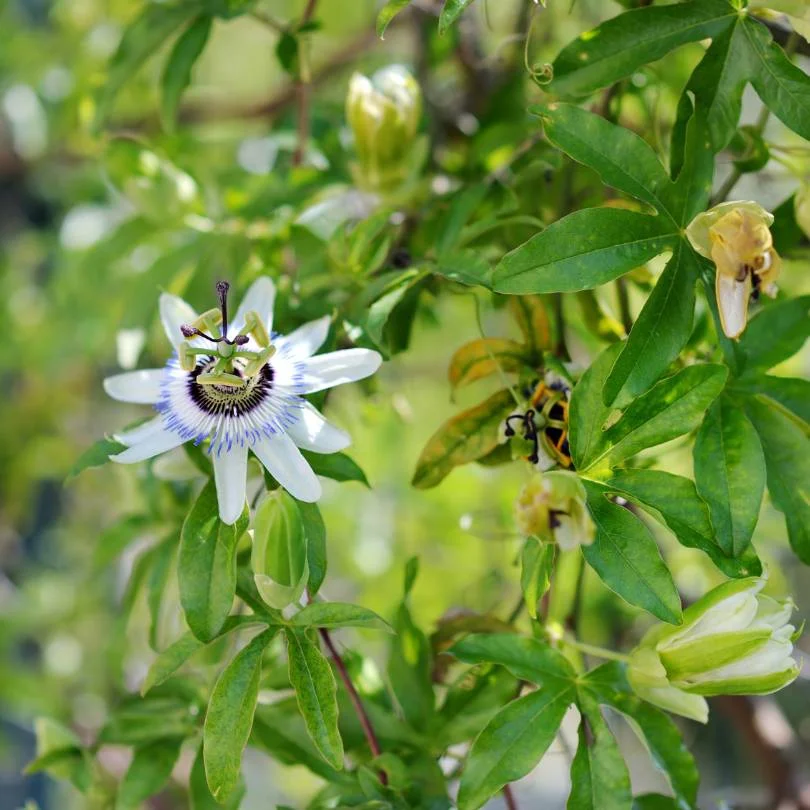
Passionflower
If you’re aiming to add a touch of the exotic to your garden, Passionflower is the plant you’ve been searching for. With its stunning, intricate blooms in vibrant purples, whites, and pinks, it’s an eye-catching vine that can transform any outdoor space into a tropical paradise. But what makes Passionflower even better? It’s completely safe for pets.
This climbing vine is easy to grow and thrives in full sun, making it perfect for trellises, fences, and arbors. The flowers, which resemble something out of a dream, bloom throughout the summer and attract pollinators like bees and butterflies, adding even more life to your garden. Despite its tropical flair, Passionflower is quite hardy and adaptable to various climates.
Plus, Passionflower has a strong, vigorous growth habit, meaning you’ll have a lush, beautiful vine in no time. Its dense foliage provides privacy, shade, and a stunning visual barrier—while keeping your pets safe. Whether you’re looking for a vibrant accent or a full-fledged climbing display, this vine is a fun and safe choice that’s guaranteed to make your garden stand out.
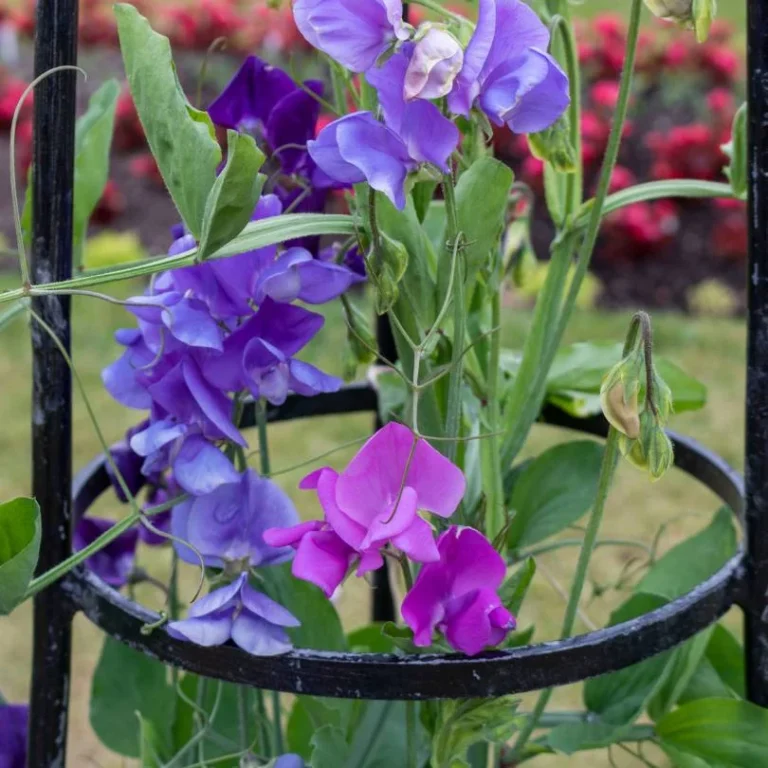
Sweet Pea
For a pet-friendly climbing plant that fills the air with a sweet, enchanting fragrance, look no further than Sweet Pea. Known for its delicate, colorful flowers that bloom in shades of pink, lavender, and white, this plant isn’t just visually stunning—it’s also safe for pets, making it the perfect choice for a worry-free garden.
Sweet Pea is an easy-growing, annual vine that loves full sun and well-drained soil. It climbs quickly, making it ideal for adding height and a burst of color to trellises, fences, and garden structures. As an added bonus, it’s also incredibly low-maintenance, requiring little attention aside from regular watering and occasional pruning to keep it tidy.
Beyond its beauty, Sweet Pea has a magical fragrance that will fill your outdoor space, making it the perfect addition to any garden where you want both visual and sensory appeal. Whether you’re growing it for its delightful scent, stunning blooms, or simply as a pet-safe climbing beauty, Sweet Pea is sure to captivate both you and your pets without any worries about toxicity.
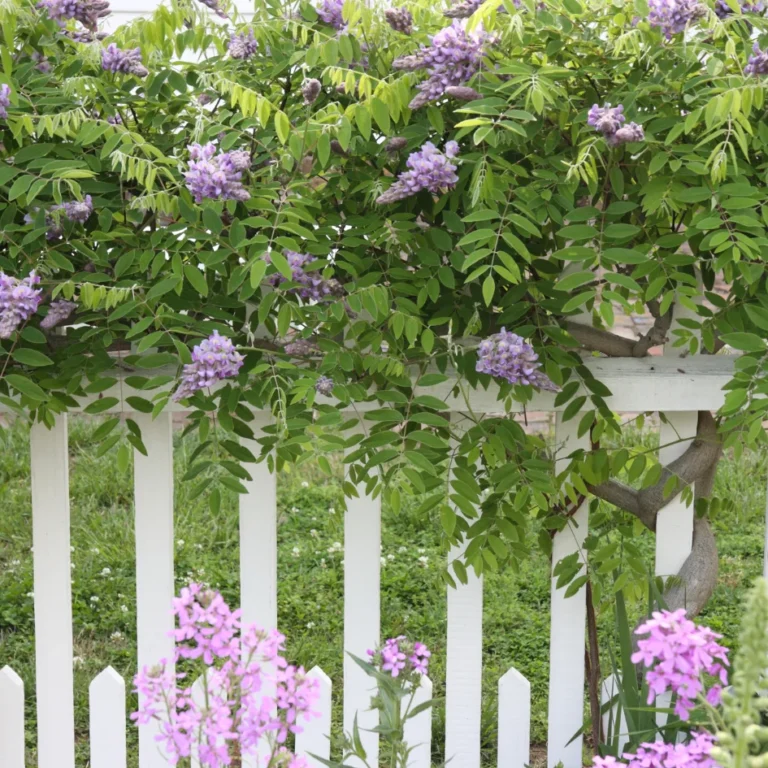
Wisteria
If you’re after a show-stopping climbing plant that will turn heads, Wisteria is your answer. With its cascading clusters of beautiful, fragrant purple flowers, this vine adds an air of elegance and sophistication to any garden. Whether climbing up a pergola, trellis, or fence, Wisteria brings a dramatic touch of color and charm.
But here’s the best part: Wisteria is non-toxic to pets, so you don’t have to worry about your curious dog or cat nibbling on its stunning flowers or vines. This makes it a perfect choice for pet owners who want to enjoy the beauty of this majestic plant without compromising their pet’s safety.
While Wisteria may take a little time to establish itself, once it does, it grows quickly and has relatively low maintenance. It thrives in full sun and well-drained soil, and once it blooms in late spring or early summer, your garden will be filled with its intoxicating fragrance. The plant’s ability to cover large areas with its long, drooping flower clusters makes it an ideal solution for creating shade or a vertical garden display.
Whether you’re looking to add beauty, fragrance, or a dramatic flair to your outdoor space, Wisteria will not only satisfy your aesthetic desires but also ensure a safe environment for your pets to enjoy.

Morning Glory
For a splash of color and a pet-friendly touch, look no further than Morning Glory. Known for its bright, trumpet-shaped flowers that bloom in shades of purple, pink, and blue, this fast-growing vine is perfect for adding a cheerful, vibrant pop to any garden. Whether climbing up a trellis, along a fence or cascading over a balcony, Morning Glory brings beauty and joy wherever it goes.
One of the best parts? Morning Glory is non-toxic to pets, so you can rest easy knowing your furry friends are safe if they decide to take a sniff or nibble on the leaves. Its vibrant flowers attract pollinators like bees and butterflies, helping to create a lively, eco-friendly garden while providing a safe space for your pets.
This vine thrives in full sun and is incredibly easy to grow, making it ideal for beginners and experienced gardeners alike. With its rapid growth, Morning Glory will quickly cover garden structures and fences, creating a beautiful living backdrop for your yard. Just make sure to give it plenty of space to spread out, as it can grow quite aggressively.
Perfect for adding some charm and color to your pet-friendly garden, Morning Glory is an eye-catching choice that’s as safe as it is stunning.

Climbing Hydrangea
For a touch of elegance and timeless beauty, Climbing Hydrangea is the perfect pet-friendly climbing plant to include in your garden. This non-toxic vine not only brings an air of sophistication to any outdoor space but also thrives in both sun and shade, making it a versatile addition to any garden.
Known for its stunning clusters of creamy white flowers and large, heart-shaped leaves, Climbing Hydrangea can easily transform a dull fence or bare wall into a lush, green focal point. Its climbing nature allows it to cover structures quickly, creating a gorgeous vertical display that’s both eye-catching and low-maintenance. The white blooms also attract pollinators, including bees, making it an eco-friendly choice for gardeners looking to support local wildlife.
Best of all, Climbing Hydrangea is completely safe for pets. Whether your dog is lounging in the garden or your cat is curiously exploring the vines, you can be assured that this beautiful plant won’t pose any risks to their health. With its fast-growing nature and relatively easy care, this plant is perfect for pet owners who want to create a lush, safe, and stunning garden retreat.
Whether you’re aiming for a romantic garden look or a simple, green escape, Climbing Hydrangea will add the perfect touch of grace and beauty without compromising the safety of your pets.

Jasmine
If you’re looking to add a touch of romance and fragrance to your garden, Jasmine is the climbing plant you need. Known for its delicate, star-shaped flowers that fill the air with a sweet, intoxicating scent, this vine isn’t just beautiful—it’s also completely safe for pets, making it the perfect addition to any pet-friendly garden.
Jasmine thrives in full sun and well-drained soil, making it ideal for growing up trellises, fences, or even over pergolas. Its fast-growing nature means you’ll get a lush, vibrant display of flowers in no time. The sweet aroma of Jasmine will make your garden smell like a tropical paradise, and the bees and butterflies it attracts will further enhance your garden’s charm.
Best of all, it’s non-toxic to pets, so you don’t have to worry about your dog or cat chewing on its leaves or flowers. Whether you’re relaxing on a summer evening or entertaining guests, the fragrance from Jasmine will add a magical touch to the atmosphere, all while keeping your pets safe.
If you’re looking for a low-maintenance yet stunning vine to add some height, fragrance, and a tropical vibe to your garden, Jasmine is a beautiful and pet-safe choice you can’t go wrong with.
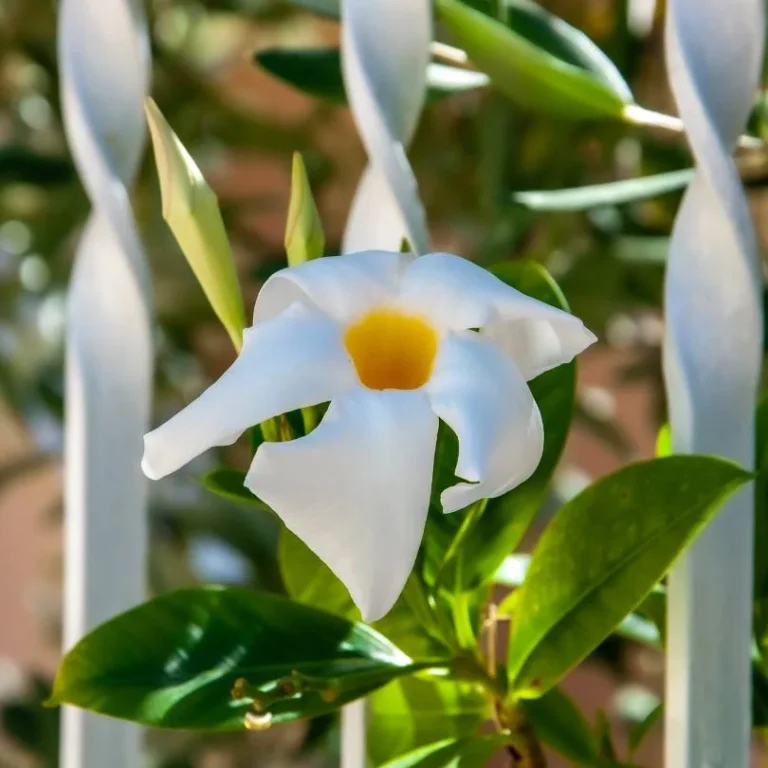
Dipladenia
Looking for a stunning, pet-safe climber that adds a pop of color to your garden? Dipladenia, also known as Mandevilla, is the perfect plant to bring both beauty and safety to your outdoor space. With its vibrant, trumpet-shaped flowers in shades of pink, red, and white, this climbing vine is sure to steal the spotlight in any garden.
Dipladenia thrives in full sun and well-drained soil, making it perfect for growing up trellises, fences, or arbors. It’s rapid growth and dense foliage will quickly cover structures, creating a lush, colorful backdrop for your garden. What’s even better? It’s non-toxic to pets, so your furry friends can safely explore the garden without any worries.
The lush, glossy leaves and striking flowers of Dipladenia not only add charm but also a touch of tropical flair. This low-maintenance plant doesn’t require much care beyond regular watering and occasional pruning, making it a great choice for both novice and experienced gardeners. Plus, its ability to attract pollinators like hummingbirds and butterflies makes it even more enchanting.
If you want a vibrant, easy-care climbing plant that’s safe for your pets and sure to make a statement in your garden, Dipladenia is an excellent choice.
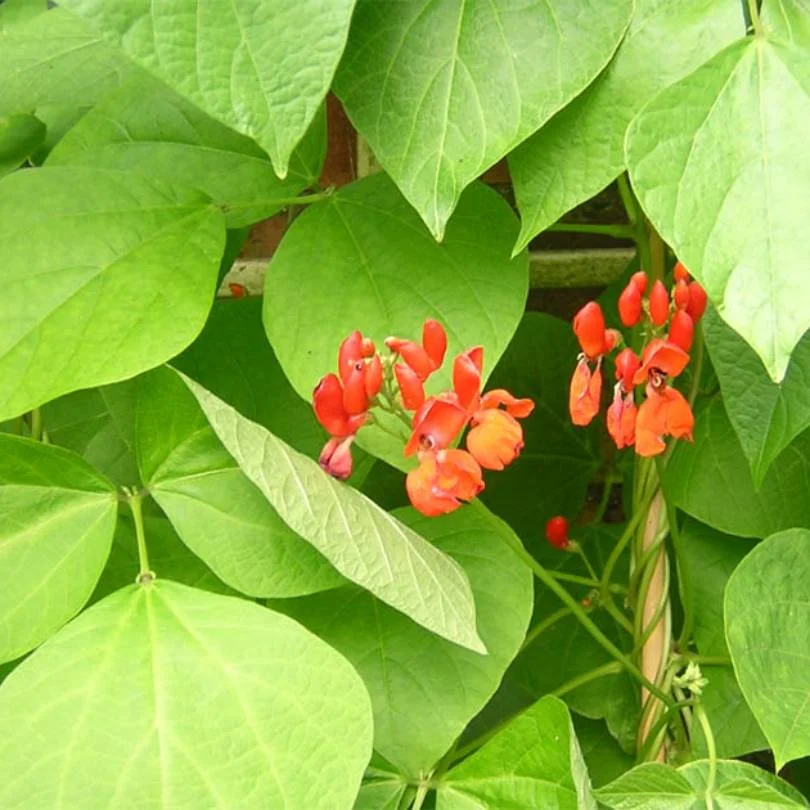
Scarlet Runner Bean
If you’re looking for a climbing plant that’s not only pet-safe but also provides a burst of vibrant color and utility, the Scarlet Runner Bean is a fantastic choice. Known for its bright red flowers and fast-growing nature, this plant is perfect for adding a bold, striking element to your garden.
While most commonly known for its edible beans, the Scarlet Runner Bean also adds beauty and interest to vertical spaces like fences, trellises, and arbors. The vivid red blooms attract hummingbirds and bees, turning your garden into a lively, buzzing haven. And the best part? Scarlet Runner Beans are completely non-toxic to pets, making them a worry-free addition to your pet-friendly garden.
This plant is not only safe for your pets but also functional. The beans it produces are edible and can be harvested for culinary use, so you can enjoy both the aesthetic beauty and the practical benefits of growing it. Plus, it grows quickly and can cover a trellis or fence in no time, making it ideal for gardeners looking for a rapid visual impact.
If you’re after a plant that offers color, safety, and even some edible rewards, Scarlet Runner Bean is an excellent option for your garden.
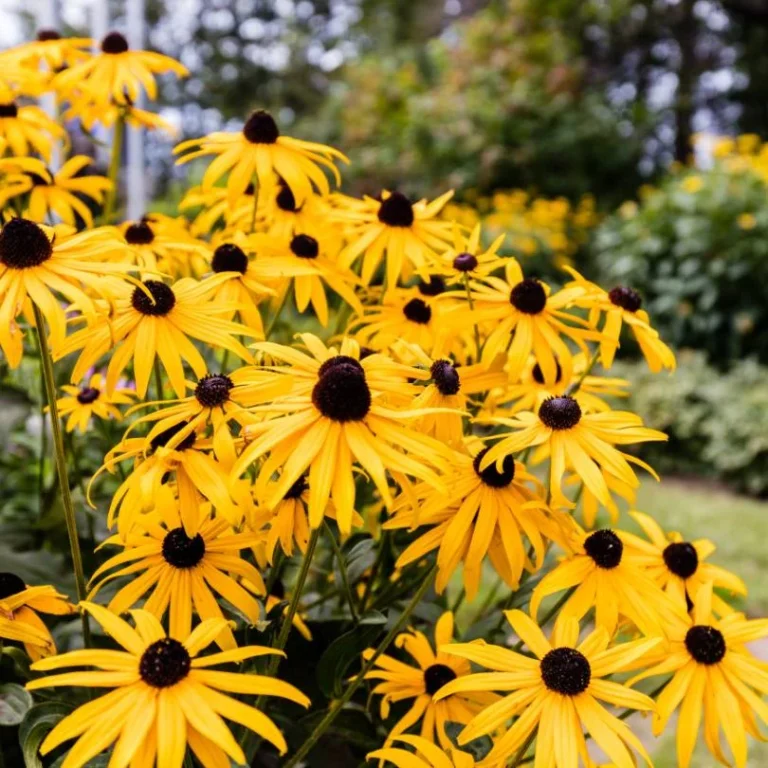
Black-eyed Susan Vine
If you want to brighten up your garden with a burst of color that’s also pet-safe, look no further than the Black-eyed Susan Vine. With its vibrant orange, yellow, and white flowers and distinctive dark center, this fast-growing vine is a perfect way to add some charm to your outdoor space.
Not only does this beauty bring cheerful color and energy, but it’s also non-toxic to pets, so your dogs and cats can enjoy your garden without a second thought. The Black-eyed Susan Vine thrives on trellises, fences, or even hanging baskets, making it incredibly versatile. Its rapid growth means you’ll have a lush display of flowers in no time, adding an instant pop of color to any part of your garden.
This vine is easy to grow, loves the sun, and attracts pollinators like bees and butterflies, making it both visually stunning and eco-friendly. With its ability to quickly cover vertical spaces, the Black-eyed Susan Vine is perfect for gardeners looking for a low-maintenance way to create a vibrant and safe outdoor retreat for both themselves and their pets.
For a colorful, easy-care climbing plant that’s safe for pets and sure to make your garden stand out, Black-eyed Susan Vine is a perfect choice.
How to Create a Pet-Safe Climbing Garden
Designing a beautiful and safe garden for pets can feel like a delicate balancing act. But don’t worry; with a bit of planning and the right plants, you can create a lush climbing paradise where both you and your furry friends can relax and enjoy. Let’s dive into the steps that will help you craft the ultimate pet-friendly climbing garden.
1. Plan Your Garden Layout With Climbing Plants in Mind
The first step in creating a pet-safe climbing garden is thoughtful planning. Think about your space—do you have a fence that needs some greenery? A pergola that could use some climbing vines? Climbing plants are perfect for adding height and beauty to any outdoor area. They can transform fences, trellises, and even garden walls into lush green canvases.
Consider placing climbing plants along vertical structures like fences or trellises that are out of reach of your pets. This way, the vines can thrive without being trampled or nibbled on. The goal is to give your climbing plants plenty of space to grow while keeping them away from curious paws and mouths.
2. Keep Plants Away from Areas That Might Be Easily Accessible to Curious Pets
Pets are naturally curious—they’ll want to explore every inch of your garden. So, make sure to plant your climbing beauties in areas that are harder for your pets to access. Consider placing plants higher up or in spots where your furry friends can’t easily get to. A trellis along a garden wall or behind a fence works perfectly for this!
For climbing plants that need a little extra attention (like frequent watering or pruning), try adding raised beds or hanging baskets. This will keep the plants safe from paws and allow you to tend to them without worry.
3. Choose Plant Types That Offer Both Shade and Beauty
When selecting plants, think about the dual benefits—beauty and safety. Choose climbing plants that not only look stunning but also serve a functional purpose. Some plants, like Hops or Clematis, grow quickly and can provide much-needed shade in your garden during hot summer months.
Additionally, consider plants with dense foliage that can offer privacy while being safe for pets. Plants like Passionflower and Wisteria will create beautiful, lush coverage, giving your garden a tropical feel while ensuring your pets can roam around without any danger.
4. Maintain Your Plants Without Exposing Pets to Risks
Once your climbing garden is in full swing, keeping it pet-safe comes down to proper maintenance. Regularly check your plants for any signs of damage or pests that could harm both your plants and pets. And be mindful of fertilizers and pesticides—opt for natural, pet-safe alternatives to avoid any risks to your furry friends.
Additionally, be sure to keep your garden free from dead plant material. Falling leaves or dead flowers can pose choking hazards or cause digestive upset if ingested. Always clean up after pruning or trimming, especially around plants with long vines like Boston Ivy or Morning Glory.
Common Mistakes to Avoid
- Planting Toxic Plants
Some plants may look harmless but are actually toxic to pets. Always double-check before adding new climbing plants to your garden to ensure they’re safe for your furry friends. - Choosing Invasive Plants
While quick-growing vines are tempting, invasive plants can quickly take over your garden, making them hard to manage in smaller spaces. Opt for plants that are easy to control and won’t spread uncontrollably. - Ignoring Growth Habits
Every climbing plant has its own unique growth pattern. Failing to consider how plants grow can lead to tangled vines, damage to structures, or overcrowded spaces. Make sure to plan accordingly to keep everything neat and safe.
Frequently Asked Questions
What are the best pet-safe climbing plants for full sun?
Some great options for sunny spots include Clematis, Dipladenia, and Passionflower. These plants love sunlight and are non-toxic to pets when grown outdoors.
Are all climbing plants safe for cats and dogs?
No, not all climbing plants are pet-safe. Some, like English ivy or bougainvillea, can be toxic. Always double-check a plant’s toxicity status with trusted sources like the ASPCA before planting.
Can I grow pet-friendly climbing plants in pots or containers?
Absolutely! Many of these vines, like Jasmine and Sweet Pea, thrive in containers with proper support. This is a great option if you’re working with limited space or a patio garden.
How can I train my climbing plants to grow vertically?
Use trellises, arbors, or wall-mounted supports. Gently tie soft stems with garden twine and guide them as they grow. Plants like Boston Ivy and Climbing Hydrangea will attach themselves naturally.
What’s the difference between climbing and trailing plants?
Climbing plants grow upward with the help of support, while trailing plants spill over edges and grow downward. Some plants, like Sweet Pea, can be trained to do either, depending on how you guide them.
Can I grow pet-friendly climbers indoors too?
Some climbers like Jasmine and Dipladenia can adapt well to indoor conditions if they get enough light. Just make sure your pets don’t chew on any plant excessively, even if it’s non-toxic.


